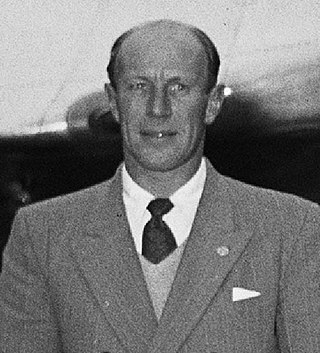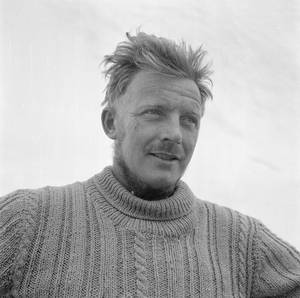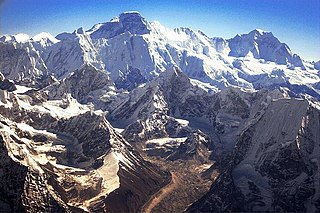Related Research Articles

Raymond Lambert was a Swiss mountaineer who together with Sherpa Tenzing Norgay reached an altitude of 8611 metres of Mount Everest, as part of a Swiss Expedition in May 1952. At the time it was the highest point that a climber had ever reached. There was a second Swiss expedition in autumn 1952, but a party including Lambert and Tenzing was forced to turn back at a slightly lower point. The following year Tenzing returned with Edmund Hillary to reach the summit on 29 May 1953.

Cho Oyu is the sixth-highest mountain in the world at 8,188 metres (26,864 ft) above sea level. Cho Oyu means "Turquoise Goddess" in Tibetan. The mountain is the westernmost major peak of the Khumbu sub-section of the Mahalangur Himalaya 20 km west of Mount Everest. The mountain stands on the China Tibet–Nepal Province No. 1 border.

Dhaulagiri is the seventh highest mountain in the world at 8,167 metres (26,795 ft) above sea level, and the highest mountain within the borders of a single country (Nepal). It was first climbed on 13 May 1960 by a Swiss-Austrian-Nepali expedition. Annapurna I is 34 km (21 mi) east of Dhaulagiri. The Kali Gandaki River flows between the two in the Kaligandaki Gorge, said to be the world's deepest. The town of Pokhara is south of the Annapurnas, an important regional center and the gateway for climbers and trekkers visiting both ranges as well as a tourist destination in its own right.

Alan Hinkes OBE is an English Himalayan high-altitude mountaineer from Northallerton in North Yorkshire. He is the first British mountaineer to claim all 14 Himalayan eight-thousanders, which he did on 30 May 2005.

Peter Habeler is an Austrian mountaineer. He was born in Mayrhofen, Austria. He developed an interest in mountain climbing at age six.

Eric Earle Shipton, CBE, was an English Himalayan mountaineer.

Mera Peak is a mountain in the Mahalangur section, Barun sub-section of the Himalaya and administratively in Nepal's Sagarmatha Zone, Sankhuwasabha. At 6,476 metres (21,247 ft) it is classified as a trekking peak. It contains three main summits: Mera North, 6,476 metres (21,247 ft); Mera Central, 6,461 metres (21,198 ft); and Mera South, 6,065 metres (19,898 ft), as well as a smaller "trekking summit", visible as a distinct summit from the south but not marked on most maps of the region.

Sir Robert Charles Evans was a British mountaineer, surgeon, and educator. He was leader of the 1955 British Kangchenjunga expedition and deputy leader of the 1953 British Mount Everest expedition, both of which were successful.

Thomas Duncan Bourdillon was an English mountaineer and member of the 1953 British Mount Everest Expedition which made the first ascent of Mount Everest. He died in Valais, Switzerland, on 29 July 1956 aged 32.

Kenton Edward Cool is an English climber and mountain guide. He is one of Britain's leading alpine and high altitude climbers and has reached the summit of Mount Everest 17 times, including leading Sir Ranulph Fiennes' 2008 and 2009 Expeditions.
The Mount Everest Committee was a body formed by the Alpine Club and the Royal Geographical Society to co-ordinate and finance the 1921 British Mount Everest reconnaissance expedition to Mount Everest and all subsequent British expeditions to climb the mountain until 1947. It was then renamed the Joint Himalayan Committee; this latter committee organised and financed the successful first ascent of Mount Everest in 1953.

Expedition style refers to mountaineering which involves setting up a fixed line of stocked camps on the mountain which can be accessed at one's leisure, as opposed to Alpine style where one carries all of one's food, shelter, equipment etc. as one climbs. Expedition style also incorporates the use of fixed ropes, and climbers will travel up and down the route several times to fix ropes and set up camps, while Alpine style eschews fixed ropes, porters, and camps, and climbers usually only climb the route once in a continuous push. Expedition style was the type of climbing Sir Edmund Hillary and Tenzing Norgay used in the first summitting of Mount Everest.
Ralf Dujmovits is a German mountaineer. In May 2009 he became the 16th person, and the first German, to climb the 14 eight-thousanders.

Alpine climbing is a type of mountaineering that involves using any of a broad range of advanced climbing skills, including rock climbing, ice climbing, and/or mixed climbing, to summit typically large routes in an alpine environment. While alpine climbing began in the European Alps, it is used to refer to climbing in any remote mountainous area, including in the Himalayas and in Patagonia. The derived term alpine style refers to the fashion of alpine climbing to be in small lightly-equipped teams who carry all of their own equipment, and do all of the climbing.

Ang Tharkay was a Nepalese mountain climber and explorer who acted as sherpa and later sirdar for many Himalayan expeditions. He was "beyond question the outstanding sherpa of his era" and he introduced Tenzing Norgay to the world of mountaineering.
After World War II, with Tibet closing its borders and Nepal becoming considerably more open, Mount Everest reconnaissance from Nepal became possible for the first time culminating in the successful ascent of 1953. In 1950 there was a highly informal trek to what was to become Everest Base Camp and photographs were taken of a possible route ahead. Next year the 1951 British Mount Everest reconnaissance expedition reconnoitred various possible routes to Mount Everest from the south and the only one they considered feasible was the one via the Khumbu Icefall, Western Cwm and South Col. In 1952, while the Swiss were making an attempt on the summit that nearly succeeded; the 1952 British Cho Oyu expedition practised high-altitude Himalayan techniques on Cho Oyu, nearby to the west.
The 1951 British Mount Everest reconnaissance expedition ran between 27 August 1951 and 21 November 1951 with Eric Shipton as leader.

The 1952 British expedition to Cho Oyu the Turquoise Goddess was organized by the Joint Himalayan Committee. It had been hoped to follow up the 1951 Everest expedition with another British attempt on Everest in 1952, but Nepal had accepted a Swiss application for 1952, to be followed in 1953 with a British attempt. So in 1952, Eric Shipton was to lead an attempt to ascend Cho Oyu, and Griffith Pugh was to trial oxygen equipment and train members for 1953. But the expedition failed both aims; that plus Shipton’s poor leadership and planning resulted in his replacement as a leader for the 1953 expedition.
References
- ↑ " City mountaineer who helped Sir Edmund Hillary climb Everest dies aged 91". Coventry Telegraph. 30 Apr 2014 By Ben Eccleston
- ↑ "Ray Colledge 1922-2014". British Mountaineering Council, Apr 20, 2014 by Lindsay Griffin
- ↑ "Repimo Shar". GREATER HIMALAYA - Climb Magazine,
- ↑ Harriet Tuckey (21 May 2013). Everest - The First Ascent: How a Champion of Science Helped to Conquer the Mountain. Lyons Press. pp. 61, 63–. ISBN 978-0-7627-9192-7.
- ↑ Peter Steele (1998). Eric Shipton: Everest and Beyond . Mountaineers Books. pp. 170–. ISBN 978-0-89886-659-9.
- ↑ "Ray Colledge ". The Times (subscription) Obituary May 4, 2014
- ↑ "Ray Colledge 26-05-1922 – 10-04-2014" Archived 2016-03-05 at the Wayback Machine . Mark Harrison, Alpine Club website
- ↑ Mick Conefrey (31 January 2014). Everest 1953: The Epic Story of the First Ascent. Mountaineers Books. pp. 49–. ISBN 978-1-59485-887-1.
- ↑ "Ray Colledge - obituary" The Telegraph, 27 Apr 2014
- ↑ "Eiger Tigers", Climber and Rambler. 1969. p. 422.
- ↑ World Climbing: Based on Mountain Magazine. Dark Peak. 1980. p. 68.
- ↑ "IN MEMORIAM - DENNIS DAVIS". By Jim Gregson Newsletter of the Karabiner Mountaineering Club, 19 February 2015
- Journal of the Midland Association of Mountaineers 1970